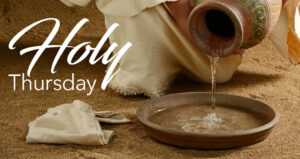Meals Shared and Rituals Born
 Holy Thursday – the first of three days that mark the culmination of Jesus’ life and ministry. The Triduum, a three day liturgy. We gather together to remember ancient traditions, as well as the events that gave birth to them and led to their continuation into our times.
Holy Thursday – the first of three days that mark the culmination of Jesus’ life and ministry. The Triduum, a three day liturgy. We gather together to remember ancient traditions, as well as the events that gave birth to them and led to their continuation into our times.
Passover was and is a fundamental feature of Jewish faith and history. The children of Jacob/Israel and their families, had found sanctuary in Egypt during a great famine. They and their descendants had grown to be a large group in the many years that followed the famine. Eventually, leadership of Egypt changed enough that they came to be seen as a potential threat and restrictions were applied that led to their enslavement.
Hearing their cries, God called Moses to intercede for them with Pharoah. When Pharoah refused to free them, a series of plagues came upon Egypt. Each was more severe than the previous one. Finally, the Lord sent the Angel of Death to slay the firstborn of all in Egypt, except those who were his own. These he had ordered to sacrifice a lamb, put some of its blood on the doorpost and lintels, and eat a communal meal of the sacrificed lamb. That night, the Angel of Death carried out its work. Pharoah ordered the Israelites to leave the land. (Ex 12:1-8, 11-14)
The Passover meal has been celebrated since that time in recognition of the great power of the Lord God and his care for his people, Israel.
Jesus and his followers were descendants of the people who escaped from Egypt. They came to Jerusalem to celebrate the Passover that year. In three of the Gospels, his last meal was a Passover celebration, but in the Gospel of John, it’s a couple of days before Passover. This is the Gospel that is featured on Holy Thursday, and the focus of this reading is Jesus washing of the feet of his disciples. (Jn 13:1-15)
Washing the feet of guests was a common thing done by hosts of any gathering. People didn’t wear closed shoes like we have today. Their feet got dirty as they walked from place to place. Servants would wash the feet of guests at banquets or other formal gatherings. But the host or the master of the household never washed anyone’s feet.
Jesus got up from the meal, took off his robe, tied a towel around himself, and began to go from one person to the next, washing their feet. Peter objected, but when told he must accept the service or not be one of the group, he accepted Jesus’ service too. When he had finished, Jesus explained to his friends that as his followers, they would be expected to follow his example. They were to become each other’s servants. More than that, they were to be servants to all, including those of lower social status.
John doesn’t tell us about the institution of the Eucharist. His focus is on the service and on the love of God.
St. Paul, however, describes the custom of the early church in his letter to the Corinthians. He tells of taking the bread, blessing it, breaking it, and sharing it as the Body of Christ, in obedience to Jesus’ command at the Last Supper when he did the same thing. Paul tells too of the sharing of the cup, transformed into Jesus’ Blood, shed for all of us, to reunite humanity with the Father. Paul’s writings predate the Gospels. This is the earliest description we have of the communal celebrations of our Thanksgiving banquet, the Eucharist. (1 Cor 11:23-26)
When I was a young girl, we were told that Holy Thursday was the day we celebrated both the beginning of the Mass and the institution of the priesthood. This was because only the priest could say the words of consecration that turned the bread and wine into the Body and Blood of Jesus.
Our understanding of Eucharist has grown and developed greatly since those early days of my life. With the inspiration of the Holy Spirit and the work of many theologians, the Church’s understanding of Eucharist has expanded. We have come to understand that through our baptism, we all share in the priestly ministry. We together offer the sacrifice of the Mass. The priest is the one who speaks the words of the Eucharistic prayer aloud, but those words include statements of our own participation in their offering. We pray with our priest, “We offer you …” The words of consecration are not the high point of the Mass. The final offering, before the Lord’s Prayer, is the high point. “Through Him, with Him and in Him…”
Yes, priesthood can be traced to the Last Supper, but so can diaconate, our ministry of service, and our very own priesthood of the non-ordained, the laity. We are all called to be part of offering Eucharist (Thanksgiving) to God. We offer our praise, our thanksgiving, and our service as a people called out of slavery. With our Jewish sisters and brothers, we can say, “Our ancestors crossed the Red Sea and our feet are wet.” We could add, “Our ancestors sat at table with Jesus, and our feet have been washed.”
As we celebrate our liturgy this day, let us remember that call to service. We transition at the end of our celebration to the quiet of the Garden of Gethsemane and the beginning of Jesus’ passion – his arrest, trial, execution, and burial. On Good Friday we will hear of those events. But for today, we give thanks and rejoice in the gift of Eucharist – our sharing in the very life of Christ.
See you at Eucharist!
Readings for Holy Thursday Mass of the Lord’s Supper
Holy Thursday Liturgy – live-stream from Resurrection Catholic Community in Aptos, CA









